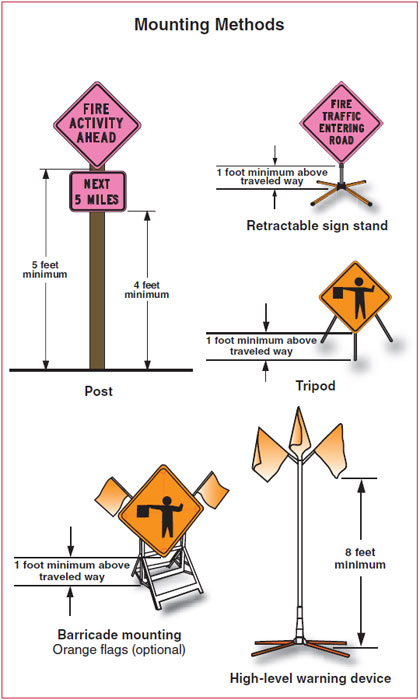Typical Installations
Methods of Mounting Signs
If the duration or scope of an incident is unknown and may change rapidly, approved portable devices may be used. Portable supports must be crashworthy. Several methods of mounting portable signs are shown on page 7. Additional information is available in the MUTCD, chapter 6F—Temporary Traffic Control Zone Devices.
Signs may be mounted on temporary sign stands, U-channel posts, existing utility poles, delineator posts, or other appropriate posts. Rollup signs are easily mounted on portable sign stands or on existing delineator posts.
If no other option exists, incident signs may be installed on the same post as similar existing signs if incident signs do not compromise the message of the existing sign.
Do not cover existing regulatory or warning signs with incident signs.
However, if existing signs conflict with incident signs, or if they do not apply during the management of the incident, cover existing signs to prevent confusion.
Signs mounted on barricades or other portable supports must be at least 1 foot above the traveled way.
Locate incident signs on the right-hand side of the road as close to the standard location of traffic signs as is practical. Where special emphasis is needed or where signs may be blocked by traffic, place signs on both sides of the roadway.
Consider the following guidelines when selecting sign placement locations:
- Place signs where they provide adequate time for proper viewer response,
considering factors such as speed, road conditions, intermediate intersections,
and road geometry (see pages 8 and 9).
- Select locations that minimize viewing obstructions. Avoid locations:
- Such as dips in the roadway or trail
- Just beyond the crest of a hill
- Where a sign could be obscured by other signs
- Where the sign may interfere with the normal operation of the facility
- Where road users have an increased need to focus on the roadway
- Erect signs individually on separate mountings except where one sign
supplements another, such as a warning sign with an advisory speed plaque, or
where incident name and destination signs are grouped.
- Relocate signs if traffic congestion extends past the original location of the signs.

Mounting Methods
(Click here for long description)
The distance from the first sign to the start of the incident area should be long enough to give road users enough time to respond to the conditions.
Use the following table to determine the distance for spacing Warning signs for activity that is not in or blocking the roadway.
| Speed limit or prevailing approach speed (miles per hour) |
Distance from incident area to the first sign and between subsequent signs (feet) |
|---|---|
| 25 or less | 100 |
| 30 to 45 | 350 |
| Over 45 | 500 |
| For expressways and freeways, contact the applicable State department of transportation. | |

*Obtain distance from table 1.
(Click for long description)

